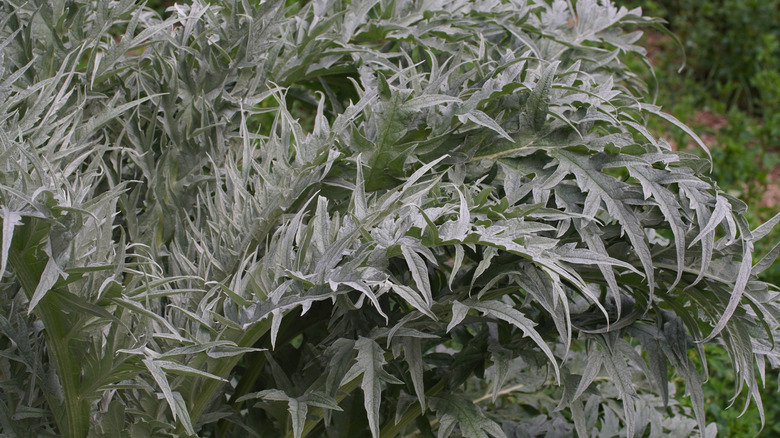Not Just The Vegetable Garden: Why Artichokes Deserve A Place In Your Flower Beds
Many people think of artichokes only as a tasty treat dipped in garlic butter. However, this vegetable, which actually comes from the thistle family, is an excellent addition that's been hiding in the background of your vegetable garden for too long. Gardeners often miss the visual appeal this plant boasts, focusing only on the edible part of the plant. The artichoke (cynara cardunculus) has a look that very few other plants can replicate. Its huge, silvery-gray leaves add significant drama and height and give your garden a Mediterranean feel. If you're looking for something that makes a major statement in your garden from spring right up until the cold weather hits, the artichoke is a perfect choice.
Artichokes are perennial in USDA Hardiness Zones 7 through 10, but gardeners in colder northern spots can grow them as an annual. Moving this edible perennial out of the vegetable garden and mixing it into your main flower borders can boost the style of your yard, adding a unique texture and color that makes all your other plants look better.
How to use an artichoke plant as a centerpiece in your flower border
One of the attractions of the artichoke is its leaf structure and color. The leaves are lobed and serrated, and the foliage can grow up to 3 feet long. This distinct appearance adds interest in the garden, standing out in contrast to other textures of flowering plants. The soft, powdery silver-green color reflects sunlight and complements the other colors in the garden. Putting an artichoke plant next to deep maroon sedums or bright magenta salvias can create a stunning effect since the leaves cool down the bolder flower colors.
Because of its size – the plant can grow 3 to 5 feet tall and spread 2 to 3 feet wide – it makes a perfect focal point or backdrop in a mixed flower border. Many gardeners grow the artichoke just for the leaves, but using it as a centerpiece can add additional texture that looks beautiful all season long, even if you never pick the edible buds. Best of all, if you live in a mild climate, this plant will come back to your garden every year.
Allowing the flower buds to bloom creates a spectacular display
The most exciting payoff comes when you don't harvest the buds and let the flowers fully open. The edible part of the artichoke is the flower bud, but if the buds are left on the plant, they will grow into violet-blue or purple thistle-like blooms. These large flowers can measure up to 7 inches across and attract bees, butterflies, and other pollinators. The purple flowers add a layer of color and interest to a garden, and they make wonderful cut flowers for fresh and dried arrangements.
In colder zones, starting seeds indoors in late winter allows artichokes time to mature and bloom before the end of the season. It's also one of the plants that are always worth buying as seedlings to get a head start on the growing season. For a happy artichoke plant, put it in a sunny spot with rich, well-drained soil and plenty of room to grow. Spacing plants about 3 to 6 feet apart is important so they have enough room to spread out and get good air circulation. A layer of mulch helps regulate soil temperature and keeps the soil consistently moist, which the artichoke appreciates, especially during the summer.


